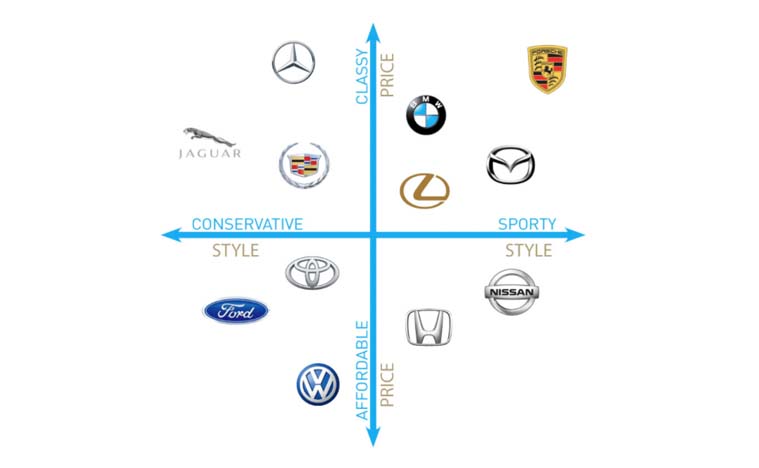Featured
What Is Positioning In Marketing? Your Complete Guide
Marketing is an ever-evolving field, with new marketing strategies and techniques emerging regularly. However, one concept that has remained a staple in marketing is positioning. Positioning is the process of creating a unique image and identity for a product or brand in the minds of consumers.
It is a critical aspect of marketing that helps companies differentiate themselves from their competitors. While effectively reaching their target audience. In this article, we will explore what positioning in marketing is, why it is important, the different types of positioning strategies, and how companies can position themselves for success.
What Is Positioning In Marketing?
Positioning in marketing refers to the process of creating an image and identity for a product or brand in the minds of consumers. This process involves differentiating the product or brand from its competitors and establishing its unique value proposition. The goal of positioning is to make a product or brand stand out in the minds of consumers. This helps it to gain a competitive advantage.
Why Is Market Positioning Important?
Market positioning is important for a number of reasons. Firstly, it helps companies differentiate themselves from their competitors. By establishing a unique image and identity, companies can create a clear and distinct brand that stands out from the competition. This can help companies to build brand loyalty and attract new customers.
Secondly, positioning helps companies to effectively reach their target audience. By understanding the needs and desires of their target audience, companies can tailor their positioning strategy to appeal to these customers. This can help to increase brand awareness and drive sales.
Thirdly, positioning can help to increase the perceived value of a product or brand. By emphasizing its unique features and benefits, companies can make their product or brand seem more valuable to consumers. This can help to increase the overall value of the brand, which can lead to increased sales and profitability.
[Read More] How To Create a Cohesive Marketing and Sales Strategy
What Are The Types Of Positioning Strategies?
There are several different types of positioning strategies that companies can use to establish a market. These include comparative positioning, differentiation positioning, and segmentation positioning.
- Comparative positioning involves positioning a product or brand in comparison to its competitors. This type of positioning strategy is often used to highlight the unique features and benefits of a product or brand, emphasizing why it is better than its competitors.
- Differentiation positioning involves positioning a product or brand based on its unique features and benefits. This type of positioning strategy is used to create a clear and distinct image for the product or brand in the minds of consumers.
- Segmentation positioning involves positioning a product or brand based on specific segments of the market. This type of positioning strategy is often used to target a specific customer group, such as a particular demographic or geographic region.
Perceptual Maps & Positioning Maps
Perceptual and positioning maps are powerful marketing tools. This comes to assist businesses in formulating a positioning strategy for their product, brand, or service. Both types of maps usually have two lines along the X and Y axis, with each line’s endpoint representing the extremes of two critical variables such as quality or price.
After the lines have been drawn and labeled with detailed criteria, existing brands or products can be plotted on the map. Once the placement of competitors has been established, a brand or product can then be positioned accordingly. It is possible to create multiple versions of each map using different sets of variables.
Although perceptual and positioning maps are similar in appearance and have interrelated concepts, they are not interchangeable. There are key differences in how they are created and interpreted.
Perceptual Map
A perceptual map displays how consumers perceive the positioning of brands that are competing or dominant products in the current marketplace. It’s crucial to keep in mind that this map only reflects consumer opinion. Which may not align with actual market reality.
While a perceptual map does not show the actual brand positioning or desired goals, it is still a valuable tool for market positioning. It provides a visual representation of how consumers view a brand’s products compared to its competitors and can help identify any potential gaps or opportunities in the market.
It’s also important to acknowledge that a perceptual map is based on consumer perceptions, which can vary. As a result, the map may not always align with a product’s actual characteristics or a brand’s intended image.
Positioning Map
A positioning map differs from a perceptual map in that it doesn’t measure consumer perceptions of products or brands. Instead, it is made up of attributes that allow for the visualization of the actual market positioning of competing brands or products.
By determining where existing brands and products are positioned in the current marketplace, businesses have the option to create positioning goals by choosing a position on the map that fills a gap or competes directly with existing brands or products.

Source: Product Marketing Alliance
How To Create A Positioning Strategy
Creating a positioning strategy involves several steps. The first step is to understand the needs and desires of the target audience. This is achievable through market research, such as surveys and focus groups, to gain a better understanding of the target audience’s preferences and buying habits.
Once the target audience has continued to be identified, the next step is to analyze the competition. This involves researching the competition’s products, branding, and marketing strategies to understand what makes them successful and how they are positioned in the market.
The third step is to define the unique value proposition of the product or brand. This involves identifying what sets the product or brand apart from its competitors and what makes it unique and valuable to consumers.
The final step is to create a positioning statement. that summarizes the unique value proposition and target audience for the product or brand. This statement should be clear, concise, and easy to understand, and should serve as a guide for all marketing and branding efforts.
[Read More] What Are KPIs In Marketing?
How To Position Your Business For Success
To position your business for success, it is important to regularly review and refine your positioning strategy. This involves monitoring the market and competition and regularly evaluating the effectiveness of the positioning strategy.
It is also important to communicate the unique value proposition of the product or brand effectively to the target audience. This is possible through various marketing and branding efforts. For example advertising, public relations, and social media.
Finally, companies should strive to consistently deliver on their unique value proposition and maintain a strong brand image. This can be achieved through consistently high-quality products and customer service, as well as effective branding and marketing efforts.
Bottom Line
In conclusion, positioning in marketing is a critical aspect of creating a successful brand image. It involves establishing a unique image and identity for a product or brand in the minds of consumers. Also, differentiating it from competitors, and appealing to its target audience. Companies can use a variety of positioning strategies. These entail comparative positioning, differentiation positioning, and segmentation positioning.
To be successful, companies must regularly review and refine their positioning strategy. Next, they should effectively communicate their unique value proposition and consistently deliver high-quality products and customer service.
By understanding the importance of positioning and implementing a strong strategy, companies can position themselves for success and achieve long-term growth and profitability.
Market Positioning FAQ
How can a company measure the success of its positioning strategy?
A company can measure the success of its positioning strategy by monitoring its brand recognition, customer loyalty, and sales figures. Regular market research and customer surveys can also provide valuable insights into the effectiveness of the positioning strategy.
How long does it take to see results from a positioning strategy?
The timeline for seeing results from a positioning strategy can vary on various dependents. Such as the size and complexity of the market, the level of competition, and the effectiveness of the strategy. On average, it may take several months to a year to see significant results. However, it is important to continuously monitor and adjust the strategy. to ensure it remains effective and relevant in the market.
Can a company have multiple positioning strategies for different products or markets?
Yes, a company can have multiple positioning strategies for different products or markets. This allows a company to tailor its positioning approach to the specific needs and preferences of each market segment, maximizing its chances for success.
How does pricing play a role in positioning strategy?
Pricing plays a crucial role in positioning strategy, as it can impact a customer’s perception of the value of a product or brand. Companies can use pricing to differentiate their products from competitors and establish a unique position in the market. For example, a company may position itself as a premium brand with higher prices, or as a budget-friendly option with lower prices.
How can a small business effectively position itself in a crowded market?
Small businesses can effectively position themselves in a crowded market. We can do this by identifying their unique value proposition and targeting a specific niche or market segment. This allows a small business to differentiate itself from larger, established competitors. While simultaneously establishing a strong brand image in the minds of consumers. Additionally, small businesses can leverage digital marketing and social media to reach their target audience. While at the same time effectively communicating their unique value proposition.
Can a product’s positioning change over time as the market evolves?
Yes, a product’s positioning can change over time as the market evolves and new competitors enter the market. Regularly reviewing and adjusting the positioning strategy is important to maintain a competitive advantage and stay relevant in the market. This may involve updating the unique value proposition, target audience, or marketing and branding efforts to reflect changes in the market and consumer preferences.
Jonathan Phillip is an up and coming writer content creator with an interest in the stock market. He's found a powerful place in writing about true growth enterprises. Yet his primary focus for the last 7 years has been creating content about the cannabis industry and marijuana stocks. He is one of the top contributors to cannabis media outlets like MarijuanaStocks.com. He also in control of social media management for StockMarket.com. From a young age Jonathan has been an active fellow of the cannabis community. Born and raised in Miami, Florida, he's been able to recognize growing trends in the space including the start of cannabis derivatives, vapes, e-liquids, wax, and more. His capability to find emerging niches has given him the capacity to find valuable information from top industry names. Jonathan has also been able to build a strong social media presence for companies. He has worked with many public companies to develop a digital presence and footprint. As an active blogger and social media influencer, his focus is also on lifestyle segments of the market. You can find Jonathan documenting on topics ranging but not limited to industry conferences and investor events to corporate disclosures and cannabis market movers. From the start of marijuana companies going public, Jonathan has made it his mission to discover information before the crowd. The main focus point of his writing is on undiscovered or under-researched companies that could carry genuine, lasting market potential. Through his due dillagence process, Jonathan has worked to be one of the early writers to find the opportunity in cannabis over other things like alcohol and he was one of the inital content creators to cover the multi-billion dollar deals that occurred in 2017 and 2018. He has also covered the emergence of multi-state operators in the U.S. after Canada paved the way in late 2018 and 2019 for legalization in North America. Jonathan is also an active member of the underground hip-hop scene. He has worked with some of the biggest names in the rap community while also gaining valuable insight from top producers and business moguls focused on moving brands forward. In his free time, Jonathan builds social communities and continues to hone his skills as a leading financial writer.












